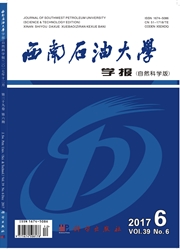

 中文摘要:
中文摘要:
QA油田X储层埋深较浅,高角度天然裂缝发育,水力压裂后形成的水力裂缝形态较为复杂,压后效果时好时坏,给压裂设计及施工带来诸多困难,急需弄清该储层水力裂缝的形态,以确定合理的压裂施工方案。首先,采用三轴岩石力学测试系统对X储层岩石力学特征进行测试,观察天然裂缝形态。其次,建立砂泥岩相间的二维平面渗流应力损伤耦合有限元模型,采用二次应力起裂准则作为水力裂缝是否起裂的判断依据,以幂律流来表征流体在Cohesive单元内的流动。模拟了X储层水力压裂多裂缝交错延伸的裂缝形态,探究了水力裂缝几何形态及压裂液排量、地应力、压裂液黏度对缝间应力干扰的影响,揭示了复杂多裂缝交错扩展的干扰机理,发现该储层具有形成复杂裂缝的力学和工程地质条件,为该区域的压裂改造提供理论指导。
 英文摘要:
英文摘要:
The X-6 Formation is located at a depth of 500–700 m in the QA Oilfield and has low porosity and low permeability.Natural high-angle fractures exist in the formation. These conditions partially satisfy the requirements for a fracture network after hydraulic fracturing but may result in relatively complex fracture patterns and introduce difficulties to the fracturing design and treatment. Firstly, triaxial tests were carried out in this work to study rock mechanical properties. A two-dimensional seepage-stress-damage-coupled finite element model of the sand- and mudstone-interlayered formation was then established.Lastly, the propagation of multiple hydraulic fractures and the stress interference mechanism of the X-6 reservoir were simulatedand the influences of the pumping rate, in situ stress, and fracturing fluid viscosity on the stress interference were studied. Theinterference mechanism of the interaction of the hydraulic and natural fracture was revealed. We found that the reservoir has complex fracture mechanical and engineering geological conditions for complex fracture generation, providing theoretical guidance for the hydraulic fracturing of the region.
 同期刊论文项目
同期刊论文项目
 同项目期刊论文
同项目期刊论文
 期刊信息
期刊信息
